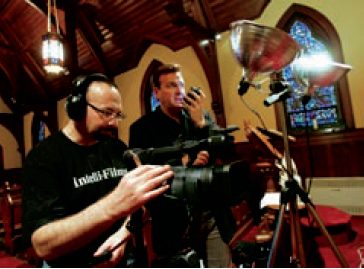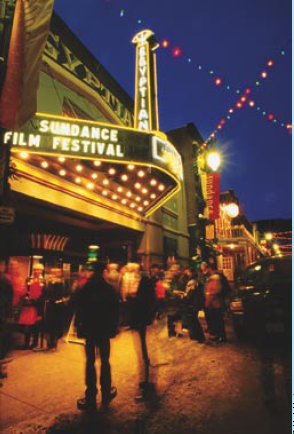

Delta Airlines sponsored a film festival in 2004 that encouraged thousands of students at eightGeorgia college campuses to become filmmakers,
some for the first time. Sarah Whitmarshmade a film about her University of Georgia student organization.
The modern U.S. film industry was born when a few courageous directors spent their own money to produce movies that Hollywood studios were not interested in financing. Public appreciation for these usually low-budget, highquality films, however, has enabled the independent film industry to grow and thrive. Kenneth Turan is the film critic for the Los Angeles Times newspaper and for Morning Edition on National Public Radio. He is the author of several books, including Now in Theaters Everywhere: A Celebration of a Certain Kind of Blockbuster (2006) and Sundance to Sarajevo: Film Festivals and the World They Made (2002).
Most countries consider themselves fortunate if they have a film industry to call their own. While some areas of the world—India and Hong Kong come immediately to mind—have industries that are thriving, the United States is privileged in having not one but two viable motion picture industries.
The first industry, the one known everywhere movies are shown, is the mainstream Hollywood business. This is where the blockbusters come from, the films like Spiderman and Pirates of the Caribbean that cost hundreds of millions of dollars to make, earn literally billions of dollars worldwide in return, and spawn sequels almost without end.
But over the past 20-plus years, a parallel American movie industry, the independent film world, has grown up and prospered. It has its own annual festival (Sundance in Park City, Utah) and its own version of the Oscars (the Independent Spirit Awards, held a few days before the Academy Awards). There are even theaters that specialize in showing independent films and actors and directors who do mostly independent work.
That doesn’t mean that there isn’t something of a symbiotic relationship between these parts of the American movie whole: There very much is. Big Hollywood stars sometimes gain praise for appearing in independent films, the way Tom Cruise did when he took a part in Paul Thomas Anderson’s Magnolia. And independent stars sometimes find a home in bigger Hollywood films, the way indie (independent) stalwart Steve Buscemi did when he appeared in traditional blockbusters such as Armageddon and The Island. And the independents have also come to be a major force in that most Hollywood of institutions, the Oscars. Finally, though, two key elements separate the Hollywood movies from the independents. One is budget—how much money a film costs to make—and the other is sensibility and subject matter—what a film is about. As always in the American movie business, the two are linked.
EMPHASIS ON ARTISTRY
When a film costs $100 million plus, as the average studio film does, it has to appeal to the widest possible audience, not only in the United States but all around the world, in order to make its money back. That means an emphasis on action, the one element that audiences everywhere respond to, as well as on the qualities that appeal to the 25-and-under crowd that is the most frequent movie going audience.
Independent films, by contrast, cost less: They can be made for anywhere from a few thousand dollars to $15 to $20 million. Though that may seem like a lot of money, by Hollywood standards it is not. And that lower cost frees these films to be more personal, more idiosyncratic, more concerned with character and story than explosions. These films can care more about artistry and self-expression and less about what will work at the box office, which is one of the reasons that they tend to do better at the Oscars than the big money-makers.
If any American movie fan wanted these kinds of experiences from movies 40 or 50 years ago, the only place he or she could get them was in foreign-language films, which is part of the reason the 1950s and 1960s saw an ever-increasing audience for films from France, Italy, Japan, Scandinavia, and elsewhere.
The independent alternative, which allowed American audiences to experience these kinds of films in their own language, did not arrive out of nowhere. The late actor and director John Cassavetes (the only filmmaker to have a prize named for him at the Independent Spirit Awards) was making independent-style films as early as 1957, when his legendary Shadows was shot. Many people also credit John Sayles’s 1980 The Return of the Secaucus Seven with starting the modern independent movement. It cost $60,000 to make, which Sayles financed himself, partly with money made rewriting studio films, and it ended up earning $2 million. For the first time it was clear that money as well as creative satisfaction could be had outside the studio system.

Actor and director John Cassevetes.
INDEPENDENT ESTABLISHMENT
Two other films, both distributed by independent world giant Miramax, the company started by Harvey Weinstein and his brother Bob and named after their parents, made it clear that independent films were here to stay. In 1989, Steven Soderbergh’s sex, lies, and videotape won the Grand Jury Prize at Sundance and went on to take the Palme d’Or at Cannes, beginning the international recognition of American independent film.
Quentin Tarantino’s Pulp Fiction did that film one better, not only winning the Palme in 1994 but becoming the first independent film to earn more than $100 million at the box office. This underlined the wisdom of the Disney organization when it acquired Miramax the previous year.
Soon every studio, understanding that independent films were too different to be made by their regular personnel, wanted to have an independent arm of its own. Today these specialty divisions (as they are known in the business) include Fox Searchlight, Warner Independent Pictures, Universal Focus, and the venerable Sony Pictures Classics.

The technology of filming and editing movies is changing, as demonstrated by the new equipment on display at a Las Vegas electronics show.
The films these specialty divisions make are the topof- the-line independent films, the ones with the biggest budgets and biggest stars. These films may seem like Hollywood movies, but the reality is that Hollywood isn’t making these kinds of films anymore. A case in point is Little Miss Sunshine. Though the film was nominated for best picture and its script ended up winning an Oscar in February 2007, it had been turned down numerous times by the major studios.
In addition to having a different sensibility, independent films can reflect different constituencies and tell different kinds of stories. Because independent films don’t have to cost a fortune, the indie world is a place where African-American directors like Spike Lee and gay directors like Gregg Araki have been able to make films that deal with marginalized characters but potentially speak to a broad audience.
THE DIGITAL EFFECT
The question of cost has also been a factor in the rise of the documentary side of the independent world. We are living through a time when more independent documentaries are being made and reaching more viewers than ever before. There are several reasons, but the real key is that the inexpensive nature of shooting with digital equipment has placed the means of production in the hands of the filmmakers.
Scott Hamilton Kennedy, a music video and commercial director, is a case in point. He would never have made the well-reviewed OT: Our Town if he hadn’t met the teacher who was putting on the Thornton Wilder play in a California high school. When she told him about her project, he knew he had to record the experience, no matter what. “I never tried to raise money, or put a crew together,” he said. “I knew that if any time was wasted trying to do all that, this moment was going to pass undocumented.”
So Kennedy went to the high school with a camera so unimpressive he said it looked like a model you can buy at Circuit City, a consumer electronics chain store. But the unintimidating nature of his equipment enabled the students to relax around him, helping to create an intimacy and trust that is the film’s greatest strength. Independence in financing leads to independent thinking, resulting in some of the finest filmmaking America has seen in years.

Filmmakers test equipment in a cathedral in Louisiana. They are producing a documentary entitled New Orleans Story about Hurricane Katrina.
Sundance—Supporting the Work of Independent Filmmakers Worldwide
The 10-day Sundance Film Festival, one of the most respected film festivals in the United States, is presented annually in January in the snowy mountains of Park City, Utah. Originally conceived as a showcase for movies by emerging independent filmmakers, Sundance has grown to include panel discussions, youth programs, online exhibition, and live music. More than 45,000 people from around the world attend the festival each year. Since it began in 1985, several American and international independent films that opened at Sundance have gone on to receive numerous Academy Award nominations and Oscars. The growing prestige of the festival attracts international celebrities to attend the screenings. The quality of the work shown has encouraged many to act in and direct independent films, often at salaries well below Hollywood standards.

Cinema fans throng each winter to Park City, Utah, for the Sundance Film Festival events.
Jury prizes and audience awards are announced on the last day of the festival in documentary and dramatic categories for both American and international films. Jurors are respected, working artists in the film industry. Awards are given for screenwriting, acting, directing, and cinematography, in addition to special awards. Not all films showcased at the festival are entered into competition; some are selected for special premieres or screenings to attract the attention of distributors, and several short films are screened in different categories and can also be viewed online at the Sundance Film Festival Web site at http: //festival.sundance.org/2007/.
In 2007, 64 American and international films in dramatic and documentary genres were screened at Sundance, and five dramas made by American directors featured characters speaking mainly in Spanish, Hindi, Korean, Portuguese, or Muskogee (an American Indian language). Most of the more than 3,000 feature films submitted for consideration focused on global issues. Companies with a major presence at Sundance include France’s Gaumont, Celluloid Dreams, and Wild Bunch; Germany’s Bavaria Film International; Denmark’s Trust Film Sales; and Fortissimo Films, an international company with offices in Amsterdam, London, Sydney, and Hong Kong. Festival director Geoffrey Gilmore has been widely quoted as saying that the Sundance Film Festival consciously made a move to increase its international focus when it introduced competitive prizes for non-American features and documentaries in 2005.
The film festival is sponsored by the Sundance Institute, which was founded in 1981 by the awardwinning actor and director Robert Redford and is also located in Park City. The institute is important not only because it exhibits films that are daring and cutting-edge in both style and subject matter, but because it provides a vast international marketplace for small and large distributors and sales companies to acquire independent films for exhibition on movie screens around the world.
The Sundance Institute sponsors numerous yearround screenings and programs that support the work of independent filmmakers, screenwriters, composers, playwrights, and theater artists. The documentary film program encourages the exploration of innovative nonfiction storytelling and promotes the exhibition of documentary films to increasingly broader audiences. Each year about 25 emerging filmmakers from the United States and abroad participate in the institute’s popular feature film program, which supports independent projects through its screenwriters’ and filmmakers’ labs and its post-production project. The program also provides ongoing creative and practical advice and financial support through fellowship opportunities. The film music program brings emerging composers to the institute, and the theater program nurtures the diversity of artistic expression among theater artists and supports original and creative work. The institute also maintains an independent film collection at the University of California, Los Angeles.



















